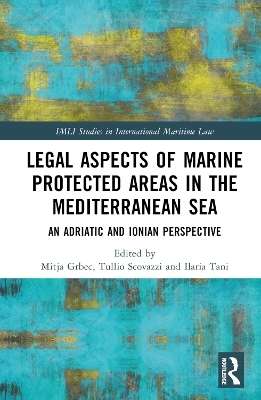
Legal Aspects of Marine Protected Areas in the Mediterranean Sea
Routledge (Verlag)
978-1-032-43564-0 (ISBN)
The objective of this book is to provide a comprehensive overview of the legal basis, under international law and the relevant regional legal frameworks, for the establishment and further development of area-based conservation tools in the Mediterranean Sea, with a particular emphasis placed on the transboundary area-based conservation instruments available for the Adriatic and Ionian Seas. Specifically, the aim is to identify and analyze the concepts and functioning of both marine protected areas (MPAs), as traditional area-based tools enabling marine habitat and species conservation, and other effective area-based conservation measures (OECMs), as a more recent addition to the picture. Further, with a view to providing responses to the complex set of challenges raised by the variety of tools and levels of intervention, conclusions and ways forward are provided that identify practical implementation instruments through which a truly transboundary perspective may guide the development of protected marine spaces in the macro-region. An essential consideration in defining the ways forward lies in that the current trend towards the establishment of exclusive economic zones could soon become an incentive towards the adoption of a coherent and coordinated Mediterranean – and Adriatic and Ionian – network of transboundary area-based conservation tools. The book will be of interest to policy makers, practitioners, and academics with an interest in public international law, the law of the sea, and sustainable ocean governance.
Mitja Grbec, Attorney-at-Law in Koper (Slovenia). Visiting Lecturer at the International Maritime Law Institute of the International Maritime Organization (IMO IMLI, Msida, Malta) and Associate Professor at University of Primorska, Faculty of Management (Koper, Slovenia). Secretary-General of the Maritime Law Association of Slovenia and Titulary Member of the Comité Maritime International. Tullio Scovazzi, Professor of international law (now retired) in the Universities of Parma, Genoa, Milan, and Milano-Bicocca (Italy). Associate Member of the Institut de droit international. Ilaria Tani, Attorney-at-Law in Milan (Italy). Adjunct Professor of international law of the sea and maritime law at University of Milano-Bicocca (Italy). Former Associate Legal Officer at the Division for Ocean Affairs and the Law of the Sea, Office of Legal Affairs, United Nations (UNDOALOS, New York, United States).
Foreword
Preface
Acknowledgements
List of abbreviations and acronyms
List of figures
List of contributors
CHAPTER 1 Mitja Grbec and Tullio Scovazzi
THE ADRIATIC AND IONIAN SEAS AS PART OF THE WIDER MEDITERRANEAN SEA
1.1. Geographical and political considerations
1.2. The present juridical picture of the Mediterranean waters
1.3. Implications of the recent process of extension of coastal State jurisdiction in the Adriatic and Ionian Seas
1.4. The Mediterranean, Adriatic, and Ionian Seas as juridically enclosed or semi-enclosed seas
1.5 Conclusive summary
CHAPTER 2 Tullio Scovazzi
THE GLOBAL LEGAL BASIS FOR MARINE AREA-BASED CONSERVATION
2.1. The domestic and international dimension of marine protected areas
2.2 The main global policy instruments
2.3 The main global legal instruments
A. The United Nations Convention on the Law of the Sea
a. Internal maritime waters
b. Territorial sea
c. Exclusive economic zone
d. Continental shelf
e. High seas
f. Seabed beyond national jurisdiction
B. The International Convention for the Regulation of Whaling
C. The Convention on Biological Diversity
a. The notion of marine protected area
b. The Jakarta Mandate
c. The Ecologically or Biologically Significant Marine Areas
d. The Aichi Targets and the Kunming-Montreal 2030 Global Targets
e. The notion of other effective area-based conservation measures
D. The Convention concerning the Protection of the World Cultural and Natural Heritage
E. The Convention for the Prevention of Pollution from Ships
a. The Particularly Sensitive Sea Areas
F. The Convention on the Protection of the Underwater Cultural Heritage
2.4. Conclusive summary
CHAPTER 3 Mitja Grbec and Tullio Scovazzi
THE REGIONAL AND SUB-REGIONAL LEGAL BASIS FOR MARINE AREA-BASED CONSERVATION
3.1. Regional instruments and their coordination with global instruments
A. The Convention for the Protection of the Marine Environment and the Coastal Region of the Mediterranean and its Protocols
a. The Areas Protocol
b. The Offshore Protocol
c. The Coastal Zone Protocol
B. The Agreement on the Conservation of Cetaceans of the Black Sea, Mediterranean Sea and Contiguous Atlantic Area
a. The proposed marine protected areas for cetaceans
C. The Agreement for the Establishment of the General Fisheries Commission for the Mediterranean
a. The fisheries restricted areas
D. The Convention on the Conservation of European Wildlife and Natural Habitats
3.2. Sub-regional instruments outside the Adriatic and Ionian Seas
A. The RAMOGE Agreement
B. The Pelagos Sanctuary Agreement
3.3. Sub-regional instruments within the Adriatic and Ionian Seas
A. Sub-regional cooperation within the institutional framework of the Barcelona Convention and its protocols
B. Cooperation within the Joint Commission for the protection of the Adriatic Sea established by the 1974 Belgrade Agreement
C. Cooperation within the framework of the intergovernmental Adriatic-Ionian Initiative
D. Cooperation within the framework of the European Union Strategy for the Adriatic and Ionian Region
3.4. Conclusive summary
CHAPTER 4 Mitja Grbec
MARINE AREA-BASED CONSERVATION UNDER EUROPEAN UNION LAW
4.1. The European Union maritime policy and its goals
4.2. The Marine Strategy Framework Directive and its regional application
4.3. The Habitats and Birds Directives
A. The Birds Directive
B. The Habitats Directive
C. The NATURA 2000 Network and the Adriatic and Ionian Seas
4.4. The European Union Biodiversity Strategy 2030
4.5. Conclusive summary
CHAPTER 5 Ilaria Tani
MARINE AREA-BASED CONSERVATION WITHIN AREAS OF NATIONAL SOVEREIGNTY AND JURISDICTION
5.1. Legal frameworks within Adriatic and Ionian States
A. Existing national legal frameworks
B. Indicators for effective national legal frameworks
a. Coordinated implementation of international and regional commitments
b. Institutional coordination
c. Specific legal provisions for marine protected areas establishment and management
d. Adoption of protection measures
e. Management planning and zoning for marine protected areas
f. Integration of marine protected areas into coastal and maritime spatial planning policies
g. Stakeholder involvement
h. Financing mechanisms
i. Monitoring, compliance, and enforcement
5.2. National marine protected areas
5.3. Conclusive summary
CHAPTER 6 Ilaria Tani
TRANSBOUNDARY AREA-BASED CONSERVATION BEYOND THE TERRITORIAL SEA WITHIN THE MEDITERRANEAN SEA AND THE ADRIATIC AND IONIAN SEAS
6.1. The Pelagos Sanctuary
6.2. Transboundary cooperation in the Strait of Bonifacio
6.3. The GFCM fisheries restricted areas
A. The Lophelia Reef off Capo Santa Maria di Leuca
B. The Jabuka/Pomo Pit
C. The Bari Canyon
D. The deep-water essential fish habitats and sensitive habitats in the South Adriatic
6.4. Conclusive summary
CHAPTER 7 Tullio Scovazzi
THE CASE FOR ESTABLISHING TRANSBOUNDARY MEDITERRANEAN SPAMIs WITHIN THE ADRIATIC AND IONIAN SEAS
7.1. Challenges and opportunities
7.2. Potential areas
7.3. Protection measures and management authorities
7.4. Conclusive summary
CHAPTER 8 Ilaria Tani
THE CASE FOR PURSUING TRANSBOUNDARY AREA-BASED CONSERVATION THROUGH A EUROPEAN GROUPING OF TERRITORIAL COOPERATION WITHIN THE ADRIATIC AND IONIAN SEAS
8.1. Legal and operational basis
8.2. Challenges and opportunities
8.3. Potential areas and protective measures
8.4. Management authority
8.5. Conclusive summary
CHAPTER 9 Mitja Grbec
THE CASE FOR ESTABLISHING A PARTICULARLY SENSITIVE SEA AREA IN THE ADRIATIC AND IONIAN SEAS
9.1. Challenges and opportunities
9.2. Work undertaken so far
9.3. Marine areas to be covered and potential associated protective measures
A. Existing associated protective measures
a. Mandatory ship reporting
b. Routeing
c. MARPOL Special Areas
B. New associated protective measures
9.4. Conclusive summary
CHAPTER 10 Mitja Bricelj
THE SUSTAINABLE DEVELOPMENT OF THE WIDER MEDITERRANEAN: MULTI-STAKEHOLDER SETTINGS, ECOSYSTEM APPROACH, AND MARITIME SPATIAL PLANNING
10.1. Multi-stakeholder settings as transboundary cooperation tools
10.2. A sustainable development strategy for the Mediterranean region
10.3. Ecosystem approach as integrated operational approach at the regional level
10.4. Ecosystem approach as integrated operational approach at the sub-regional level
10.5. Ecosystem approach in the integrated coastal zone management
10.6. Maritime spatial planning and green (and blue) infrastructure
10.7. Conclusive summary
CHAPTER 11 Iztok Škerlič
A PERSPECTIVE FROM THE EUSAIR FACILITY POINT: MARITIME SPATIAL PLANNING AS A CROSS-PILLAR ELEMENT OF THE STRATEGY
11.1. The EUSAIR Action Plan and its contribution to the implementation of the Coastal Zone Protocol
11.2. Interactions between the blue economy and environmental quality in the EUSAIR
11.3. The Facility Point project as a support tool to the EUSAIR (maritime) governance process
11.4. Conclusive summary
CHAPTER 12 Mitja Grbec, Tullio Scovazzi, Ilaria Tani
CONCLUSIVE REMARKS ON AN ADRIATIC AND IONIAN SEAS RESPONSE TO GLOBAL CHALLENGES IN THE FIELD OF ENVIRONMENTAL PROTECTION: TOWARDS COORDINATED NETWORKS OF MARINE PROTECTED AREAS?
12.1. Challenges and existing opportunities
12.2. Objectives and ways forward
List of references
| Erscheinungsdatum | 13.09.2023 |
|---|---|
| Reihe/Serie | IMLI Studies in International Maritime Law |
| Zusatzinfo | 35 Halftones, black and white; 35 Illustrations, black and white |
| Verlagsort | London |
| Sprache | englisch |
| Maße | 156 x 234 mm |
| Gewicht | 600 g |
| Themenwelt | Recht / Steuern ► Allgemeines / Lexika |
| Recht / Steuern ► EU / Internationales Recht | |
| ISBN-10 | 1-032-43564-X / 103243564X |
| ISBN-13 | 978-1-032-43564-0 / 9781032435640 |
| Zustand | Neuware |
| Haben Sie eine Frage zum Produkt? |
aus dem Bereich


